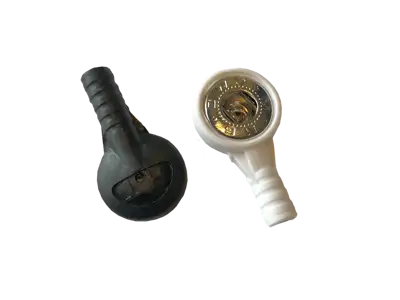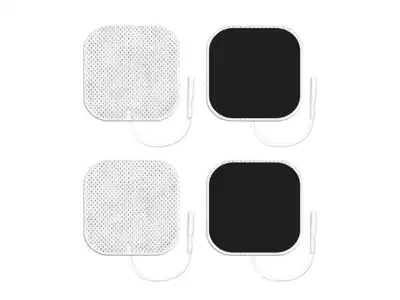Adhesive electrodes
The TENS electrode for home electrostimulation treatments (TENS - nerve stimulation, pain relief;EMS - muscle stimulation;Microcurrent - pain relief, healing treatment) is an essential tool. The pulse is transmitted from the device to your body through an adhesive "peg" attached to the skin. Without it there is no treatment and no effect. In this article, I summarise the most important information to help you make the right choice.
Main features of the TENS electrode
- connector type (needle, patent, clip, other)
- size and shape (square, rectangular, round, oval, other)
- layers (overlay, gel, conductive, adhesive)
- use (single or multiple applications)
- driving quality.
Type of connector
Cables from electrotherapy equipment manufacturers usually
- needle (PIN) or
- patent (SNAP) or
- are made with other non-standard connectors.
The larger, medical-grade manufacturers usually have standard PIN or SNAP connectors, so you can connect any PIN or SNAP electrode to these. You just need to pay attention to the termination of your device's cable.
Some health wellness manufacturers (e.g. Omron, Beurer, Vivamax) have non-standard connectors. For these, the standard one will not "fit".
This is a marketing ploy. You buy the device cheap and later realize that the replacement electrode costs 8-9 thousand forints. If you have to use the device regularly it becomes many times more expensive.
Size and shape
You can find the most varied sizes and shapes on the market. The most common shapes and sizes
- square (4x4 or 5x5cm)
- rectangle (5x9 or 5x10cm)
- circle (diameters 2.3, 3, 5 cm)
- oval (3x5, 7.5x13 cm)
- butterfly and other shapes.
When choosing the size, take into account the area to be treated! Obviously, a 7.5x13 cm oval electrode pair will not fit on your face, but round electrodes with a diameter of 2.5 - 3cm are suitable. For your calves, on the other hand, the larger 7.5x13cm oval electrodes are fine. For general analgesia (TENS or MENS), a 4 to 5 cm square electrode is suitable. I recommend the same for muscle stimulation of the neck, shoulders, arms and for motor points (larger muscles: thighs, abdomen, breasts, back). For muscle stimulation, I recommend the 5x9, 5x10cm electrodes as electrodes further away from the motor point. Note that for stimulation, a current of 2mA/cm2 is generally recommended. That is, a 5x5 electrode is 25cm2, so the maximum current recommended is 50mA. The smaller the electrode, the smaller the area over which the current is concentrated. A higher current will cause a more unpleasant sensation.
Layers, materials
The materials and thickness of the electrode determine the flexibility of the electrode. The thicker and stiffer an electrode is, the less it will pick up the contours of the body.
Inexpensive electrodes usually consist of three layers: adhesive, gel and covering layers. The current is conducted into the gel layer and is distributed in it. Better quality electrodes (types: PALS, Ultrastim, ValueTrode) consist of two gel layers, an adhesive, a conductive layer and a covering layer. The double gel layer provides a more even current distribution, which reduces the unpleasant pinching sensation associated with the treatment. The top layer is usually textile, foam, paper or a special material.
The thicker and stiffer electrodes on larger muscles, thighs, back, abdomen, buttocks smooth the skin properly. However, they are not suitable for treating a thin wrist, neck, etc. because they do not lie on strong curves.
Cheap (usually Chinese) electrodes are stiff, their edges curl up in the hairline, they sag. Therefore the current delivery is concentrated in a small area. This makes for an unpleasant handling experience. The PALS electrodes represent the highest level. They contain stainless steel mesh, are extremely thin and flexible. And the mesh covering the entire surface ensures perfect current distribution over the entire surface. In UltraStim electrodes, the conductive layer is a silver fibre mesh. It also provides excellent current distribution, but is slightly stiffer. The general purpose ValueTrode electrodes do not have a separate conductive filament. The current is conducted into the double gel layer, which provides good distribution, but the electrode is more rigid.
How to choose an electrode?
An electrical impulse will trigger the desired response in your body if it is of the right intensity (current). However, the higher the intensity, the more uncomfortable the treatment can feel. Above a certain current intensity, pain prevents the treatment from continuing.
If the electrode is of poor quality, it has poor conductivity. The device must be set to a high current to be effective, but this will increase the pain. But if the pulse is not strong enough, the effect will be lost.
A better conductive electrode will deliver the right pulse at a lower current. This makes for a more effective treatment.
You should buy a Chinese electrode if you want to train as a fakir. A poor quality electrode will guarantee an uncomfortable and ineffective treatment.
Generally true: if you can afford it financially, go for the best quality and that's PALS electrodes. If price is not an issue, then proceed as follows.
For pain relief (TENS and Microcurrent) treatments
Usually, the use of ValueTrode electrodes is sufficient. For TENS and Microcurrent treatments they are suitable for diameters of 40-50mm. You stick these around the pain and perform the stimulation that way.
For Bell's palsy and facial cosmetic treatments
For the treatment of the face and neck, a small diameter electrode (25-30 mm) is required, as the muscles are small and the lack of space means that larger electrodes cannot be placed with a few cm of space between them.
I recommend using the 32mm ValueTrode Round or the 25mm PALS Round electrodes for the face.
For denervated (paralysed muscle) treatments
The damaged nerve is sensitive. The better quality the electrode you use, the gentler you are on the nerve. So it's worth using PALS or UltraStim electrodes.
Depending on the muscle you want to treat, you can use 25-32mm round electrodes (e.g. facial nerve palsy) or 5x5 and 5x9cm (peroneal palsy), etc.
For muscle stimulation treatments
For muscle stimulation, there are two trends regarding the size of electrodes to use.Some recommend electrodes with a larger surface area, while others recommend electrodes of different sizes.
Those in favour of larger size argue that the larger the electrode, the easier it is to distribute the current in the muscles, the higher the comfort level, the higher the current intensity and the stronger the muscle contraction.
The opinion of those who advocate different sizes is that the smaller electrode should be placed on the muscle belly (most prominent part). With the smaller electrode, more current is concentrated on the motor nerve plate (moving nerve), which is located directly in the center of the muscle. It is also believed that it can reach much deeper parts of the muscle before reaching another electrode located nearby.
I recommend trying both variations and decide which you feel is more effective based on your experience.
| PALS | UltraStim | ValueTrode | Obtrusive | |
| Number of use | 15-20 | 20-25 | 15-20 | 5-10 |
| Gel layers | double | double | double | single |
| Conductive layer | stainless steel mesh | silver mesh | none | none |
| For TENS treatment | Excellent | Excellent | Excellent | OK |
| For MENS treatment | Excellent | Excellent | OK | Not recommended |
| For muscle stimulation | Excellent | Excellent | OK | Suitable |
| For denervated muscle | Excellent | Excellent | OK | Not appropriate |
| For Bell's palsy | Excellent | Excellent | OK | Not appropriate |
| Flexibility | Flexible | Flexible | Unflexible | Unflexible |
You can increase the life of your self-adhesive TENS electrode (peg) with careful use
The electrodes that come with your device can be used repeatedly for up to 20-30 treatments, depending on the quality. In any case, there comes a point when they stop sticking, dry out and no longer transmit the pulse properly. At that point you will need to buy a new electrode, which, if you use the device frequently, means recurring expenditure.

- The electrodes are supplied glued to a plastic sheet.
- Carefully peel them off the sheet. Do not touch the glue as this will reduce its adhesion.
- Make sure the adhesive surface does not get on the ground, do not stick it to clothes, as dirt will quickly impair adhesion.
- Before sticking the electrode to your skin, wash the area of skin to be treated with lukewarm, soapy water (degrease) and towel dry. Only apply the electrode to completely dry skin.
- After use, peel off your skin in one motion and stick back on the plastic sheet for storage immediately. Do not pull by the cord, as the cord may tear!
- Keep the electrode in the fridge! Not in a freezer, but in a regular refrigerator. This will increase the lifetime.
- If the surface of the electrode is already dry, drop a drop of water on the electrode to get a few extra uses.
- After a while, the electrode won't stick at all. At that point, you can extend its life even further by using contact gel and sticking plaster.
- This should not be done for a long time, because dry electrodes do not transmit the pulse and the effect of the treatment is reduced or lost.
- There will come a time when you will be forced to replace the self-adhesive electrode with a new one.
By considering and applying the above, you can maximize both the lifespan of your electrodes and the effectiveness of your treatment, while also optimizing your costs.
Can the self-adhesive electrode be replaced?
If you want to avoid repeated costs, you can use "permanent" electrodes. These are usually made of rubber-carbon-silicone materials, meaning they are virtually indestructible and you can use them for years. They are non-sticky and non-gelled. They require a rubber tape with Velcro or a separate adhesive tape (e.g. leuco-plast) to hold them in place. They cannot be used "dry", you need to use a contact gel to transfer the impulse to your skin (without a gel, the treatment will burn and sting).
- Choose from specially designed large-surface electrodes for treating your belly-bottom-comb (FastPads, Flexible Electrode)
- You can simplify the treatment of your waist and abdominal muscles with an electrotherapy belt (FastBand Belt, UltraStim Belt)
- For muscle stimulation, you can use silicone carbon electrodes
- Incontinence can be treated with electrodesinserted into the vagina or anus
- A sponge-covered carbon electrode is used for iontophoresis


















